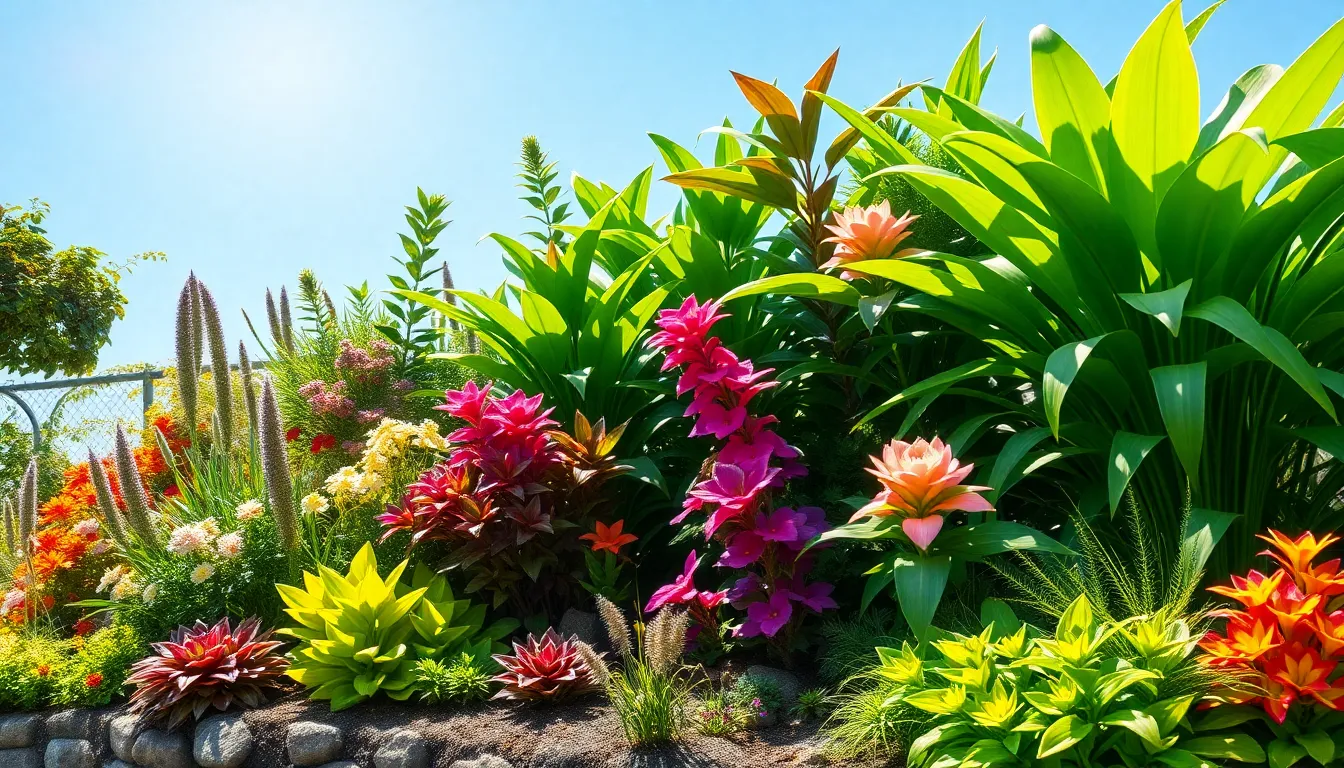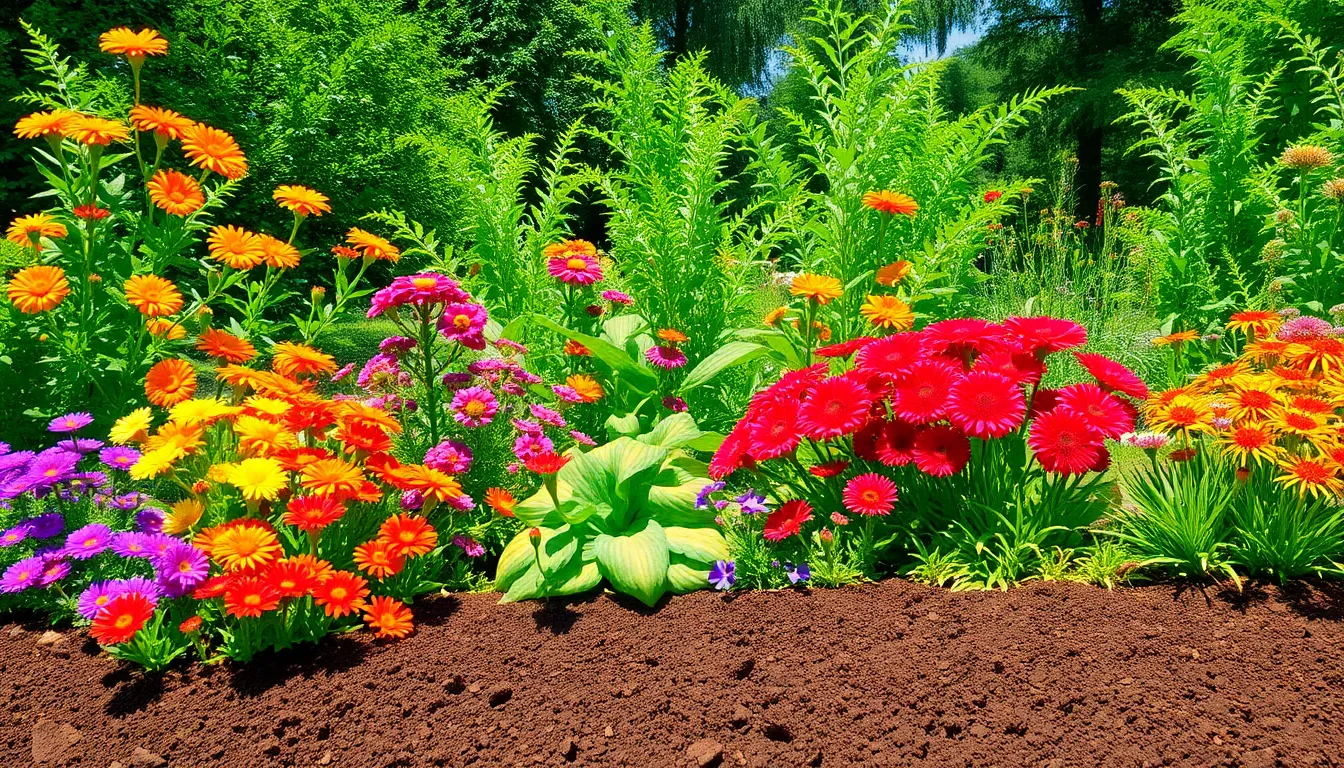Transforming a yard from drab to fab can feel like an uphill battle. But fear not! With the right plants for landscaping, anyone can turn their outdoor space into a lush paradise. Imagine stepping into your backyard and feeling like you’ve just entered a botanical wonderland—minus the admission fee.
Plants for Landscaping
Choosing the right plants enhances outdoor aesthetics and functionality. Various types of plants serve distinct roles in landscaping.
Trees
Trees provide shade, structure, and visual interest in landscaping. Large species like oak or maple create canopies, while smaller ornamentals like dogwood or Japanese maple add beauty in compact spaces. Evergreen trees contribute year-round greenery, helping to define spaces and provide privacy. Deciduous trees, on the other hand, offer seasonal color shifts. They thrive in diverse environments, from urban settings to residential yards.
Shrubs
Shrubs function as versatile elements in landscaping. Varieties like boxwood and holly serve as effective hedges, providing privacy and windbreaks. Flowering shrubs, such as hydrangeas and azaleas, introduce vibrant color and attract pollinators. Additionally, low-maintenance options like lavender offer both fragrance and drought resistance. Shrubs fill gaps in garden beds, ensuring year-round interest and texture.
Perennials
Perennials form the backbone of many gardens with their returning blooms. Popular options include coneflowers and daylilies that thrive in a range of conditions. These plants provide seasonal beauty while having the advantage of requiring less maintenance after establishment. Many perennials also attract beneficial insects, supporting local ecosystems. Their diverse shapes and sizes contribute to rich landscapes.
Annuals
Annuals add vibrant color and variety to landscapes with their ephemeral blooms. Flowers like petunias and marigolds thrive in sunny locations, offering bursts of color throughout the growing season. These plants can fill in gaps in garden beds or provide seasonal displays in containers. They often require more attention, but their ability to create impactful visual displays makes the effort worthwhile. Annuals allow for creative expressions in flower arrangement and garden design.
Factors to Consider When Choosing Plants


Selecting the right plants requires thoughtful consideration of various factors to ensure a thriving landscape.
Climate Zone
Understanding climate zones helps in identifying plants suitable for the local environment. Each zone experiences different temperatures and weather conditions that affect plant growth. For instance, USDA Plant Hardiness Zones range from 1, representing the coldest conditions, to 13, which encompasses warmer regions. Local climate plays a crucial role in determining what plants will thrive, so research is essential for ensuring success.
Soil Type
Evaluating soil type is vital for plant health and growth. Different plants prefer various soil textures, such as sandy, clay, or loamy soils. Soil pH also affects nutrient availability, influencing plant selection. For example, azaleas thrive in acidic soil, whereas lilacs prefer alkaline conditions. Testing soil quality can provide valuable insights into what plants will perform best, promoting a flourishing landscape.
Sunlight Requirements
Assessing sunlight requirements ensures optimal plant performance. Some plants, like sunflowers and lavender, thrive in full sun, needing at least six hours of direct sunlight daily. Others, such as ferns and hostas, prefer shaded areas with minimal sunlight. Evaluating the light exposure in different parts of the landscape helps in selecting plants that will flourish, enhancing the overall aesthetic appeal.
Designing Your Landscape with Plants
A well-designed landscape enhances outdoor spaces by integrating various plants. Selecting the right plants creates unique visual experiences.
Creating Focal Points
Focal points draw attention and provide structure. Consider using large, striking plants, such as ornamental trees or vibrant flowering shrubs, to anchor the design. Placing a bold specimen in the center of a garden bed establishes interest. Using garden sculptures or water features alongside plants adds depth and texture. Incorporating contrasting colors makes focal points even more effective, ensuring they stand out. Each carefully chosen element contributes to an engaging visual narrative throughout the landscape.
Planting for Color and Texture
Color and texture play crucial roles in creating a dynamic landscape. Grouping plants with varied leaf shapes and sizes forms intriguing compositions. Bright annuals, such as petunias or marigolds, provide seasonal bursts of color. Mixing perennials, like daylilies and hostas, adds layers of interest that change year-round. Color palettes can evoke specific moods, with warm colors energizing spaces and cool tones promoting tranquility. Textural contrasts, like soft grasses against sturdy shrubs, enhance visual appeal and create a more inviting environment.
Maintenance Tips for Landscaping Plants
Proper care ensures landscaping plants remain healthy and vibrant. These practices enhance their beauty and longevity.
Watering Techniques
Water depth varies based on plant type. Most plants thrive with one inch of water weekly. Early morning watering reduces evaporation. Drip irrigation systems efficiently deliver water directly to roots. Soil moisture levels dictate watering frequency, as drought-tolerant plants require less frequent irrigation. Rain gauges help monitor precipitation to adjust schedules accordingly.
Pruning and Grooming
Timely pruning promotes plant health. Remove dead or diseased branches immediately to prevent disease spread. Shape plants during dormancy to encourage fuller growth. Regular deadheading in flowering plants boosts blooms. Fertilizing after pruning nourishes new growth effectively. Some plants benefit from winter grooming to maintain shape and reduce wind damage.
Pest Control
Integrated pest management practices work best for healthy plants. Regular inspections reveal early signs of pests or diseases. Natural predators effectively control common pests without harsh chemicals. Neem oil serves as an organic solution for various infestations. Maintaining plant health through proper care minimizes susceptibility. Following labeled instructions ensures safe chemical application when necessary.
Conclusion
Creating a stunning landscape is within reach for anyone willing to invest time and effort into selecting the right plants. By understanding the unique needs of each plant and considering environmental factors like climate and soil type, individuals can cultivate a thriving outdoor space. The combination of trees, shrubs, perennials, and annuals can transform an ordinary yard into a vibrant oasis.
With thoughtful design elements and proper maintenance techniques, the beauty of a well-planned landscape can flourish year-round. Embracing these principles not only enhances the visual appeal of a property but also fosters a deeper connection with nature, making outdoor spaces more inviting and enjoyable.





